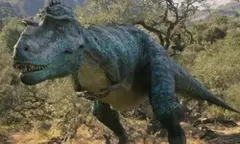| Gorgosaurus Temporal range: Late Cretaceous | |
|---|---|

| |
| Gorgon the gorgosaurus that appears in WWD | |
| Scientific classification | |
| Kingdom: | Animalia |
| Phylum: | Chordata |
| Class: | Sauropsida |
| Superorder: | Dinosauria |
| Order: | Saurischia |
| Suborder: | Theropoda |
| Genus: | †Gorgosaurus Lambe, 1914 |
| Species: | G. libratus |
| Binomial name | |
| Gorgosaurus libratus Lambe, 1914 | |
Gorgosaurus (meaning "fierce lizard") is an extinct genus of theropod and carnivorous dinosaur that reached 8 to 9.3 meters (26 to 30 feet) in length, and weighed 2.8-3.4 tonnes. It was first described by paleontologist Lawrence Morris Lambe in 1914, and has been found in western Canada and the United States. It lived about 76-75 million years ago in the late Cretaceous period.[1][2][3]
Description[]

Gorgosaurus skeletal reconstruction by randomdinos
Over 20 Gorgosaurus skeletons have been recovered, making it the most well-represented tyrannosaurid in the fossil record. Generally similar to Tyrannosaurus and most other large tyrannosaurids (such as Daspletosaurus, and Albertosaurus), Gorgosaurus can be described as having a massive head, large, curved teeth, tiny two-fingered front limbs, and powerful legs.[4]
Compared to the other tyrannosaurids, Gorgosaurus is most similar to its very close relative Albertosaurus.
Although it has been suggested that Gorgosaurus was a scavenger, its co-existence with the similarly sized, but more robust tyrannosaurid Daspletosaurus casts doubt on this theory.
Another hypothesis proposes that Gorgosaurus, which was rather lean for a tyrannosaurid, actively hunted fleet-footed animals such as duckbills and ornithomimids ("ostrich-mimic" dinosaurs). According to this proposition, the more troublesome ceratopsians and ankylosaurians (horned and heavily armoured dinosaurs) would have been left to Daspletosaurus and Gorgosaurus would have hunted on less armored hadrosaurs. An apex predator, it was at the top of the food chain.
For years, the species Gorgosaurus libratus (the only species of Gorgosaurus currently recognized) was assigned to the Albertosaurus genus. However, recent work done by paleontologists suggest that enough differences exist between G. libratus and the other Albertosaurus species, to justify the original genus name of Gorgosaurus.[5]
Discovery and naming[]
Gorgosaurus libratus was first described by Lawrence Lambe in 1914. Its name is derived from the Greek gorgos ("fierce" or "terrible") and saurus ("lizard").[6]
Further Information[]
Gorgosaurus was noticeably smaller than Tyrannosaurus or Tarbosaurus, closer in size to Albertosaurus and Daspletosaurus. Adults reached 8 to 9.3 m (26 to 31 ft) from snout to tail and a body weight of around 3 tonnes.[7][8]
The largest known skull measures 99 cm (39 in) long, just slightly smaller than that of Daspletosaurus. As in other tyrannosaurids, the skull was large compared to its body size, although chambers within the skull bones and large openings (fenestrae) between bones reduced its weight. Gorgosaurus has a proportionally shorter skull than Albertosaurus, Daspletosaurus and other tyrannosaurids.[9][10]
The end of the snout was blunt, and the nasal and parietal bones were fused along the midline of the skull, as in all other members of the family. The eye socket was circular rather than oval or keyhole-shaped as in other tyrannosaurid genera. A tall crest rose from the lacrimal bone in front of each eye, similar to Albertosaurus and Daspletosaurus. Differences in the shape of bones surrounding the brain set Gorgosaurus apart from Albertosaurus.[11]
Classification and systematics[]
Gorgosaurus is classified in the theropod subfamily Albertosaurinae within the family Tyrannosauridae.[12]
Paleobiology[]
Life history[]
Gregory Erickson and colleagues have studied the growth and life history of tyrannosaurids using bone histology, which can determine the age of a specimen when it died.[13]
There is also another specimen; that was a subadult that found to ate a small dinosaur called Citipes.[14][15][16][17]
Paleoecology[]
Most specimens of Gorgosaurus libratus have been recovered from the Dinosaur Park Formation in Alberta.
In popular culture[]
- Gorgosaurus had a large role in the movie March of the Dinosaurs, where it was shown to be "king of the forest", and it has feathers. In reality, it was both feathered and scaly.
- It also had a large role in Walking with Dinosaurs: The 3D Movie, where it is seen as the main antagonist, and it accurately lacks feathers. Among them was the mighty Gorgon. Murderer of Patchi’s and Scowler’s father, Bulldust, and enemy of Patch, his older brother, Scowler, and his girlfriend, Juniper.
- Gorgosaurus appeared in Fossil Fighters, Fossil Fighter Champions, and Fossil Fighters Frontier, as a Fire element revivable dinosaur.
- It also appears in Jurassic World: The Game as a tournament dinosaur. It sports a prominent crest on its snout, and seems to be covered in crocodilian armor on its back when it likely had some feathers on bare skin and avain scales on legs and no crest in life.
- Gorgosaurus will be in Jurassic World: Alive, being fairly similar to the Walking With Dinosaurs version.
- Gorgosaurus is featured in Dinosaur King.
- In Planet Dinosaur, it appeared in the database in Episode 3, Last Killers.
- In Fantasia, there is a skeleton in the graveyard in the middle of the desert in The Rite of Spring.
Gallery[]
References[]
- ↑ https://www.thoughtco.com/gorgosaurus-1091806
- ↑ https://www.nhm.ac.uk/discover/dino-directory/gorgosaurus.html
- ↑ https://www.mcgill.ca/redpath/learning-services/resources/dinosaurs/gorgosaurus
- ↑ https://gagebeasleyprehistoric.com/profiles/gorgosaurus/
- ↑ https://a-dinosaur-a-day.com/post/125447403865/gorgosaurus-liberatus
- ↑ https://treatment.plazi.org/GgServer/html/B97187EFFFE04A2CFCE4FD657CE7FE4C
- ↑ https://www.mindat.org/taxon-4822628.html
- ↑ https://www.researchgate.net/figure/Comparison-of-various-adult-tyrannosaurids-Gorgosaurus-libratus-a-Albertosaurus_fig3_226839476
- ↑ https://dinosaurpictures.org/Gorgosaurus-pictures
- ↑ https://www.sothebys.com/en/buy/auction/2022/natural-history/gorgosaurus
- ↑ https://www.rareresource.com/gorgosaurus.htm
- ↑ https://www.enchantedlearning.com/subjects/dinosaurs/facts/Gorgosaurus/index.shtml#google_vignette
- ↑ https://www.activewild.com/gorgosaurus-facts-for-kids-and-students/
- ↑ https://www.sci.news/paleontology/gorgosaurus-libratus-diet-12517.html
- ↑ https://www.nytimes.com/2023/12/08/science/tyrannosaur-last-meal-gorgosaurus.html
- ↑ https://kurious.ku.edu.tr/en/news/last-supper-of-a-young-gorgosaurus/
- ↑ https://www.washingtonpost.com/science/2023/12/08/tyrannosaurus-fossil-stomach-contents/











